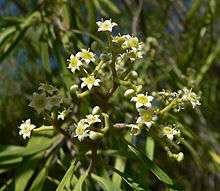Geijera parviflora
| Wilga | |
|---|---|
 | |
| Scientific classification | |
| Kingdom: | Plantae |
| (unranked): | Angiosperms |
| (unranked): | Eudicots |
| (unranked): | Rosids |
| Order: | Sapindales |
| Family: | Rutaceae |
| Genus: | Geijera |
| Species: | G. parviflora |
| Binomial name | |
| Geijera parviflora Lindl. | |
| Synonyms | |
| |
Geijera parviflora, commonly known as the Wilga or Native Willow, is a small tree or bush found in inland parts of eastern Australia. It features thin drooping leaves, up to 18 cm (7 in) long. It was first described by English botanist John Lindley in 1848,[1] Other vernacular names include sheepbush and dogwood.[2] The specific epithet parviflora is from the Latin, meaning "small flowers".
Wilga may grow to 10 metres (33 feet) tall, and has drooping branches. The leaves are linear to spear-shaped (lanceolate) and range from 3.5 to 18 cm (1.4 to 7.1 in) long and 0.4–1 cm (0.16–0.39 in) wide.[3] They give off a strong smell when crushed.[2] The small white-petalled flowers of this member of the citrus family occur between June and November.[3] Their smell has been described as foetid, and they attract blowflies.[2] The flowers have also been described as strong smelling or citrus scented[4] and attract insects. The fruit are globose in shape, around 5 mm long, inside are shiny black seeds.[3] Regeneration from fresh seed and cuttings has proven to be difficult. It is suggested that the hard seed coat should be cracked, to assist seed germination.[5]
Wilga prefers calcareous soils - either red clays or sandy soils, and grows as scattered trees in open woodland or occasionally in stands.[2] It is found in inland Australia, from central-western New South Wales and Queensland and Victoria into South Australia.[3]
Wilga is a useful shade and fodder tree in agricultural areas. Sheep particularly enjoy grazing on the lower branches, although trees appear to vary greatly in palatability (some are eagerly sought after and others ignored). The reason for this variation is unknown, and soil composition is speculated as a cause.[2] Despite being slow growing, it is planted in Australia and overseas as an ornamental. It prefers full sunshine, and can tolerate the occasional light frost and drought. Indigenous Australians chewed the aromatic leaves for alleviating toothache.[4]
Gallery
-
Willowy leaves of the Wilga
-

habit of the Wilga
-
flower close up
-
Wilga flowers attract insects
References
- ↑ "Geijera parviflora Lindl.". Australian Plant Name Index (APNI), IBIS database. Centre for Plant Biodiversity Research, Australian Government.
- 1 2 3 4 5 Cunningham, Geoff M.; Mulham, William E.; Milthorpe, Peter L.; Leigh, John H. (1981). Plants of Western New South Wales. Sydney, New South Wales: NSW Government Printing Service. pp. 447–48. ISBN 0-7240-2003-9.
- 1 2 3 4 "Geijera parviflora". PlantNET - NSW Flora Online. Retrieved 8 March 2011.
- 1 2 Greig, Denise. A Photographic Guide to Trees in Australia. p. 102. ISBN 1-86436-326-6.
- ↑ Growing Australian Native Plants From Seed by Murray Ralph, ISBN 978-0-646-42866-6